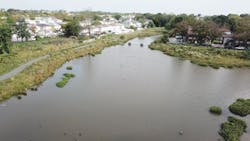New York City officials have announced the completion of a $110 million flood control project that expands the New Creek Bluebelt.
Bluebelts are ecologically rich and cost-effective drainage systems that naturally handle the runoff precipitation that falls on streets and sidewalks. New York City has used the New Creek Bluebelt to provide both critical support to Staten Island’s drainage infrastructure and beautiful open green space for residents, while creating diverse habitats for wildlife. The New Creek Bluebelt now covers 94 acres and drains a 2,249-acre watershed area.
This portion of the New Creek Bluebelt expansion consists of three connected projects, with construction done in separate phases. With all three phases now complete, stormwater that falls on roadways, rooftops, and sidewalks in portions of the Midland Beach, Grant City, Dongan Hills, and Todt Hill neighborhoods of Staten Island will now drain into new catch basins and storm sewers and be discharged into the New Creek Bluebelt. From there, it will slowly make its way to the lower New York Bay while being naturally filtered along the way.
“Eleven years after Superstorm Sandy stole 44 of our neighbors, family members, and loved ones, the need for major investments in flooding infrastructure has only grown as climate change continues to create stronger storms and extreme weather events. Too often, our concrete jungle gives rain no place to go, leaving communities to manage devastating flooding without the necessary infrastructure. But with this $110 million expansion of the New Creek Bluebelt, Staten Island is more prepared than ever,” said New York City Mayor Eric Adams. “These bluebelts are a key part of our broad strategy to protect New York City from flooding. The days of Staten Island being the ‘forgotten borough’ are over. We will not allow any borough in our city to experience another Superstorm Sandy without being prepared.”
“Today we celebrate how New Yorkers can have it all, a bluebelt that creates open space, greenery, wildlife and critical absorption to protect Staten Islanders against more frequent, heavier and more unpredictable storms,” said Deputy Mayor of Operations Meera Joshi, “Bluebelts are one of many ways the Adams administration maximizes every square foot, turning it into green infrastructure to protect New Yorkers against flooding. We will continue to be creative and opportunistic to build a more resilient city.”
Originally implemented on Staten Island, the bluebelt program preserves natural drainage corridors including streams, ponds, and wetlands, and revitalizes and enhances them to optimize their functions of conveying, storing, and filtering stormwater. New York City has used bluebelts as a mechanism for reducing urban flooding while creating a rich natural environment for the local community.
“Bluebelts are a key strategy for managing stormwater throughout the city, making New York more resilient to changing climate. These innovative drainage systems reengineer existing wetlands to protect communities from inland flooding, while also providing beautiful open spaces for residents and wildlife,” said New York City Chief Climate Officer and Department of Environmental Protection (DEP) Commissioner Rohit T. Aggarwala. “As we seek natural solutions to fortify neighborhoods against extreme weather, we need look no further than to the successful development and implementation of the bluebelt program right here on Staten Island.”
To complete this multiphase expansion of the New Creek Bluebelt, the city most recently concluded a $42 million project in Midland Beach, which encompasses 12 acres and features the largest man-made wetland in the bluebelt system. Enhancements feature two outfalls, stilling basins to reduce water velocity, micropools and forebays to provide maintenance points, and a weir chamber at Olympia Boulevard to regulate the downstream flow of water as it makes its way toward the lower New York Bay.
The Midland Beach project also included adding more than 85,400 wildflowers and natural plants, 810 native shrubs, 440 trees, 6,000 linear feet of storm sewers, 2,150 linear feet of sanitary sewers, and 5,300 linear feet of water mains.
Prior to the Midland Beach site, the city undertook the $25 million “Gateway to the Bluebelt,” which created a panoramic-like viewing area introducing the public to the rehabilitated New Creek wetlands. This three-part expansion of the New Creek Bluebelt began with a $43 million project that saw two new wetlands built at Last Chance Pond Park.






